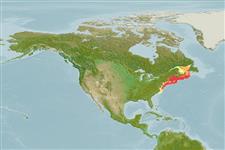Classification / Names
Common names from other countries
Main reference
Size / Weight / Age
Max length : 66.0 cm TL male/unsexed; (Ref. 40637); max. published weight: 3.6 kg (Ref. 40637)
Length at first maturity
Lm 26.0 range ? - ? cm
Environment
Marine; demersal; oceanodromous (Ref. 51243); depth range 35 - 1152 m (Ref. 57178), usually 110 - 130 m
Climate / Range
Temperate, preferred 9°C (Ref. 107945); 51°N - 33°N, 79°W - 58°W
Distribution
Northwest Atlantic: North Carolina to southern Nova Scotia, straying to the Gulf of St. Lawrence. Rare European records are probably misidentifications of Urophycis tenuis.
Countries | FAO areas | Ecosystems | Occurrences | Introductions
Short description
Dorsal
spines
(total): 0;
Anal
spines: 0. First dorsal fin ray elongated. Pelvic fins also reaching about the anal fin origin. Body color variable, reddish to olive brown dorsally, sometimes very dark or mottled; lower sides paler, sometimes with dusky dots; belly and underside of the head pale. A dusky blotch present on the opercle. The fins are generally dark, except for the pelvic fins, which are pale.
IUCN Red List Status (Ref. 115185)
Threat to humans
Harmless
Human uses
Fisheries: commercial; gamefish: yes
Tools
Special reports
Download XML
Internet sources
Estimates of some properties based on models
Phylogenetic diversity index
PD50 = 0.5044 many relatives (e.g. carps) 0.5 - 2.0 few relatives (e.g. lungfishes)
Trophic Level
3.7 ±0.3 se; Based on diet studies.
Resilience
Medium, minimum population doubling time 1.4 - 4.4 years (K=0.19; tm=2-3)
Vulnerability
Moderate to high vulnerability (51 of 100)
Price category
